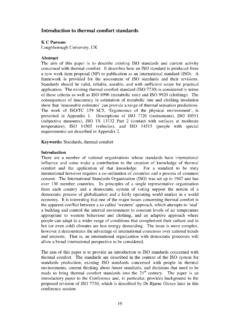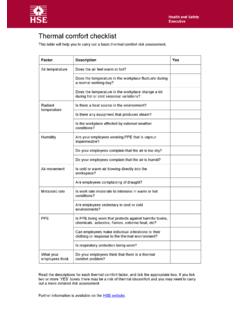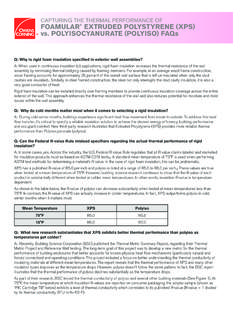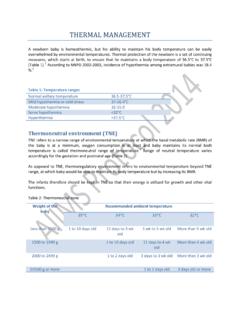Transcription of Thermal Comfort - LabEEE
1 Thermal Comfort Page 1 of 25. Thermal Comfort This booklet is an introduction to Thermal Comfort . It explains procedures to evaluate the Thermal environment and methods applied for its measurement. Contents What is Thermal Comfort ? How is Body Temperature regulated? How does man evaluate the Thermal Environment? First conditions for Thermal Comfort The Comfort Equation Metabolic Rate estimation Clo value calculations What should be measured? What is Mean Radiant Temperature and how to measure it? What are Operative, Equivalent and Effective Temperatures? Operative and Equivalent Temperature can be measured directly How to create Thermal Comfort The PMV and PPD scales Local Thermal Discomfort Draught Evaluating the Draught Rate Asymmetry of Thermal Radiation Vertical Air Temperature Difference Floor Temperature How to perform a measurement in a workplace How to evaluate the Thermal Quality of a room Further Reading Appendices: A: Dry Heat Loss calculations file://K:\Marketing\Homepage\Gammel%20 Homepage\Website\books\ Thermal \ 20-12-2002.
2 Thermal Comfort Page 2 of 25. B: Heat Balance, Comfort and PMV equations C: Met value table D: Clo value table E: Calculation of Mean Radiant Temperature F: Calculation of Plane Radiant and Operative Temperature. Nomenclature What is Thermal Comfort ? Man has always striven to create a thermally comfortable environment. This is reflected in building traditions around the world - from ancient history to present day. Today, creating a thermally comfortable environment is still one of the most important parameters to be considered when designing buildings. But what exactly is Thermal Comfort ? It is defined in the ISO 7730 standard as being "That condition of mind which expresses satisfaction with the Thermal environment". A definition most people can agree on, but also a definition which is not easily converted into physical parameters.
3 The complexity of evaluating Thermal Comfort is illustrated by the drawing. Both persons illustrated are likely to be thermally comfortable, even though they are in completely different Thermal environments. This reminds us that Thermal Comfort is a matter of many physical parameters, and not just one, as for example the air temperature. Thermal environments are considered together with other factors such as air quality, light and noise level, when we evaluate our working environment. If we do not feel the everyday working environment is satisfactory, our working performance will inevitably suffer. Thus, Thermal Comfort also has an impact on our work efficiency. How is Body Temperature regulated? Man has a very effective temperature regulatory system, which ensures that the body's core temperature is kept at approximately 37 C.
4 When the body becomes too warm, two processes are initiated: first the blood vessels vasodilate, increasing the blood flow through the skin and subsequently one begins to sweat. Sweating is an effective cooling tool, because the energy required for the sweat to evaporate is taken from the skin. Only a few tenths of a degrees increase in the core body temperature can stimulate a sweat file://K:\Marketing\Homepage\Gammel%20 Homepage\Website\books\ Thermal \ 20-12-2002. Thermal Comfort Page 3 of 25. production which quadruples the body's heat loss. If the body is getting too cold, the first reaction is for the blood vessels to vasoconstrict, reducing the blood flow through the skin. The second reaction is to increase the internal heat production by stimulating the muscles, which causes shivering. This system is also very effective, and it can increase the body's heat production dramatically.
5 The control system which regulates the body temperature is complex, and is not yet fully understood. The two most important set of sensors for the control system are however known. They are located in the skin and in the hypothalamus. The hypothalamus-sensor is a heat sensor which starts the body's cooling function when the body's core temperature exceeds 37 . C. The skin-sensors are cold sensors which start the body's defence against cooling down when the skin temperature falls below 34 C. If the hot and cold sensors output signals at the same time, our brain will inhibit one or both of the body's defence reactions. How does man evaluate the Thermal Environment? Man considers the environment comfortable if no type of Thermal discomfort is present. The first Comfort condition is Thermal neutrality, which means that a person feels neither too warm nor too cold.
6 When the skin temperature falls below 34 C, our cold sensors begin to send impulses to the brain; and as the temperature continues to fall, the impulses increase in number. The number of impulses are also a function of how quickly the skin temperature falls - rapid temperature drops result in many impulses being sent. Similarly, the heat sensor in the hypothalamus sends impulses when the temperature exceeds 37 C, and as the temperature increases, the number of impulses increase. It is believed that it is the signals from these two sensor systems that form the basis for our evaluation of the Thermal environment. The brain's interpretation of the signals is assumed to be like a tug-of-war, with the cold impulses at one end of the rope and the warm impulses at the other. If the signals on both sides are of the same magnitude, you feel thermally neutral, if not, you either feel too warm or too cold.
7 A person in a thermally neutral state and completely relaxed makes for a special case, as he will activate neither the heat or cold sensors. It takes some time to change the body's core temperature; the signal from the heat sensor therefore change very slowly compared to the signals from the cold sensors. file://K:\Marketing\Homepage\Gammel%20 Homepage\Website\books\ Thermal \ 20-12-2002. Thermal Comfort Page 4 of 25. First conditions for Thermal Comfort Two conditions must be fulfilled to maintain Thermal Comfort . One is that the actual combination of skin temperature and the body' s core temperature provide a sensation of Thermal neutrality. The second is the fulfilment of the body' s energy balance: the heat produced by the metabolism should be equal to the amount of heat lost from the body. The relationship between the parameters: skin temperature, core body temperature and activity, which result in a thermally neutral sensation, is based on a large number of experiments.
8 During these experiments the body' s core temperature, the skin temperature and the amount of sweat produced were measured at various known levels of activity, while the testpersons were thermally comfortable. The results of the experiments can be seen in the figure. Sweat production was chosen as a parameter instead of the core body temperature, but as the sweat production is a function of the deep body and skin temperature this does not in principle change anything in the Thermal sensation model. No differences between sexes, ages, race and national-geographic origin were observed in the above experiment, when determining: What is a thermally comfortably environment? However, differences was observed between individuals on the same matter. The equations controlling the energy balance for a person are relatively simple.
9 They can be seen in Appendix B. The Comfort Equation The equation for comfortable skin temperature and sweat production can be combined with the equation for the body' s energy balance to derive the Comfort Equation. This equation describes the connection between the measurable physical parameters and thermally neutral sensation as experienced by the "average" person. The Comfort equation provides us with an operational tool which by measuring physical parameters enables us to evaluate under which file://K:\Marketing\Homepage\Gammel%20 Homepage\Website\books\ Thermal \ 20-12-2002. Thermal Comfort Page 5 of 25. conditions Thermal Comfort may be offered in a workplace. The Comfort Equation derived by Fanger /1/ is too complicated for manual arithmetic and is normally solved using a computer. The full equation can be seen in Appendix A and Appendix B.
10 The equation reveals that the temperature of the surfaces in the enclosure where a person is has a huge influence on Thermal sensation. A 1 C change in surface temperature may under many circumstances have as large an influence on a persons Thermal sensation as a change of 1 C in the air temperature. Furthermore, the Comfort equation reveals that the humidity level only has a moderate influence on the Thermal sensation. In practise, it is important to know which input parameters the Comfort Equation requires. These are: 2 table values giving the persons activity and clothing levels. (Clo and Met values). 2-4 measured parameters describing the Thermal environment in the workplace. Metabolic Rate estimation The metabolism is the body' s motor, and the amount of energy released by the metabolism is dependent on the amount of muscular activity.





